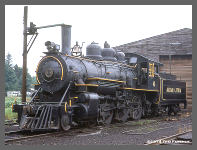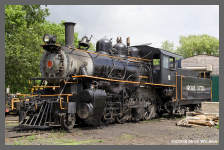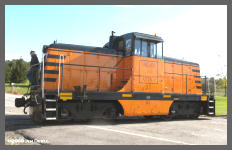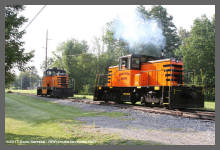| Back to History Page |
 |
This page is devoted to some of the many historical articles about railroading in the Western New York area. This installment was written by Society member John Baker as it appeared in our April/May 1985 issue of the "Railway Flyer." Many more past articles will be added as time allows. So sit back, or feel free to print out, and enjoy the rich railway heritage of Western New York. |
| The first recorded attempt to build a railroad through Tonawanda Valley into Arcade occurred in 1836 when a group of local businessmen formed the "Attica and Sheldon Railroad" as a means of serving the area's farming and agriculture industry. This proposed project was a failure and no work was ever done. In late 1852, the "Attica and Allegheny Valley Railroad" was formed. This railroad proposed to build a narrow gauge line from Attica to Arcade, then south to the Pennsylvania line in Cattaraugus County. Its principal business was expected to be coal, shipped north to Buffalo. The railroad managed to acquire the right-of-way, and grade the property between Arcade and Attica, install bridge abutments, and purchase rail before going bankrupt. Construction was halted in 1856 and the line was abandoned. Early in 1870, the "Attica and Arcade Railroad" was formed. This line proposed a 3 foot narrow gauge running from Attica to Arcade. By 1873, little work had been done and the Village of Attica launched an investigation. Inspection reveled financial wrong doing, and the Attica and Arcade was promptly declared bankrupt. Its organizers had suddenly left the area. In April of 1880, R.N. Farnham formed the "Tonawanda Valley Railroad" and was incorporated with $250,000 from the "Erie Railroad." This line planned a 24 mile narrow gauge railroad between Attica and Sardinia (Chaffee). A connection with the "Buffalo, New York & Philadelphia Railroad" (now CONRAIL) would be made at Sardinia. The TVRR was officially opened between Attica and Curriers on September 11th, 1880 On October 26th, 1880, the "Tonawanda Valley Extension Railroad" was organized to build the extension between Curriers and Sardinia. However, without legal authority, the railroad was built south to the Village of Arcade. By the 1st of May 1881, the rails had been laid into the Village. By late 1882 the railroad, now know known as the "Tonawanda Valley & Cuba Railroad," was extended south to the town of Cuba. Unfortunately, it could not have come at a worse time as the oil industry collapsed later that year. By 1885, it was apparent that the line was in financial trouble. In December the debt reached $130,000 and the railroad ceased operations for the winter. Limited service was resumed in the spring of 1886 and the railroad continued to operate until 1889 when new management took over. However, they fared no better and abandoned all operations in the early 1890’s. There was still belief that rail service could be operated profitably between Arcade and Attica. On October 13th, 1894, the "Buffalo, Attica & Arcade" was organized. The new railroad began at once to change to modern standard gauge operation. In January 1895 service was begun between Curriers and Attica and by December, trains were operating into Arcade. In 1902, the BA&A announced grand plans to build a branch from Java Center through Wales to Buffalo. No work was started and the idea faded away with the news that the new line was being planned to operate over the same route. In September of 1902, the "Buffalo and Susquehanna Railway" was incorporated and construction begun. The B&S ran from Wellsville to Buffalo passing through Arcade. However, the route to Buffalo operated instead through Springville, not Wales as planned. Operations began 1906 and the B&S purchased the BA&A for $75,000, thus local ownership was lost. The B&S operated the line until 1916, but losses were so severe that the railroad was abandoned and scrapped later that year. The BA&A was also in serious financial trouble and shut down for the winter 1916-17. |
| In 1951 General Manager R.I. Cartwright, testified that the A&A had carried only 8 passengers in the first quarter, for a total revenue of $1.80. It was decided that all passenger service be discontinued and on August 1st, 1951, the last mixed train made its run. Thus, the railroad was without passenger service for the first time in its history. Mother Nature dealt the A,&A cruel blow on January 23rd, 1957. As a result of a rapid thaw and very heavy rains, several hundred feet of track was washed out along Tonawanda Creek south of Attica. It was estimated that repairs would cost more than $72,000 which was more than the A&A could afford. It was decided to abandon the road north of North Java. The mainline connection would be maintained at Arcade Junction with the Pennsylvania Railroad. During the early 1960’s, freight revenues declined and something had to be done to augment this situation. Other short lines had begun to operate steam excursions and the A&A decided to give it a try. By now #6 had long been scrapped and the A&A needed a steam locomotive. |
| In 1969 the A&A handled more than 2400 freight cars, up from less than a 1000 in 1960. In 1981, its centennial year, the A&A carried more than 30,000 passengers. Also in that year, the A&A was declared to be a national historic site. The determined little railroad with its checkered past is looking to a prosperous future through a combination of its passenger and freight service. |
 |
 |
 |
 |
Updates 2018 - Arcade & Attica Locomotive Roster
|
| Back to History Page |
Web Site Hosting by TRAIN WEB
The WNYRHS, Inc., 100 Lee Street, Buffalo, NY. 14210 is an independent organization and has no affiliation with any other local or national group.
The Society is a fully qualified organization under 501 (C) (3) of the Internal Revenue Code and all donations to the Society are tax deductible.
©Copyright 1999 , WNYRHS Inc. all rights reserved